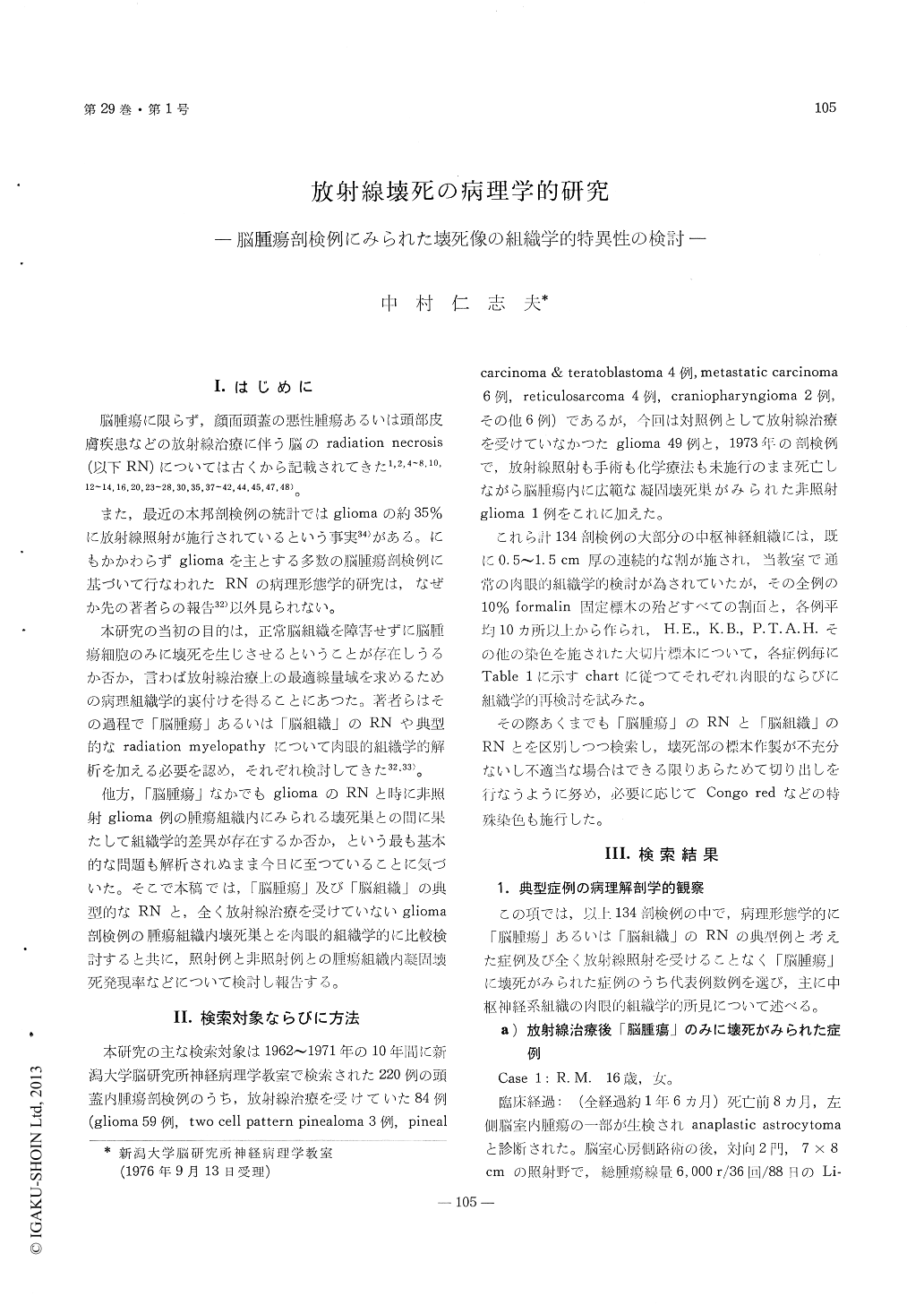Japanese
English
- 有料閲覧
- Abstract 文献概要
- 1ページ目 Look Inside
1.はじめに
脳腫瘍に限らず,顔面頭蓋の悪性腫瘍あるいは頭部皮膚疾患などの放射線治療に伴う脳のradiation necrosis(以下RN)については古くから記蔵されてきた1,2,4〜8,10,12〜14,16,20,23〜28.30,35,37〜42,44,45,47,48).
また,最近の本邦剖検例の統計ではgliomaの約35%に放射線照射が施行されているという事実34)がある。にもかかわらずgliomaを主とする多数の脳腫瘍剖検例に基づいて行なわれたRNの病理形態学的研究は,なぜか先の著者らの報告32)以外見られない。
Typical macro- and microscopical findings of the radiation necroses of brain tumors and the sur-rounding brain tissue were analysed pathomor-phologically based on 84 autopsy cases of irradiatedintracranial tumors, including 59 cases of gliomas. A comparative-study followed with the findings of coagulation necroses in non-irradiated brain tumors.
The typical coagulation necroses of the "normal" brain tissue, attributable to irradiation, were gener-ally observed in the cerebral white matter pre-senting somewhat whitish yellow colored ap-pearances without remarkable changes in their own volume. The histology of them revealed complete disintegration of myelin and axon without any cell elements survived ; and there were various vascular changes predominantly observed in smaller blood vessels, such as hyalinous thickening, concentric cleavage, fibrinoid degeneration, adventitial fibrosis and edema of small arteries, fibrin thrombi or oc-clusion of arterioles and capillaries, as well as telangiectasia of small veins and venules.
As for the typical radiation necroses of brain tumors, while those of craniopharyngioma and other tumors were of hyalinous or fibrous scar tissue often showing decrease in their original volume, those of gliomas maintained their original massive volume almost unchanged without residual tumor cells. In histology also, they had many resemblances to those of "normal" brain tissue.
Even in the non-irradiated gliomas which were observed as control case, massive coagulation necroses were occasionally found in the tumor tissue maintaining their own volume ; however, the vascular changes in those necroses were not so rich in variety as in the typical radiation necrosis. Additionally in some of the cases which were irradiated in relatively small doses, it seemed very difficult to judge only by histopathological findings whether the necroses in those tumors were caused by irradiation or occurred spontaneouly.
But, the coagulation necroses in the tumor tissue were found in 25 out of 59 cases (42%) of irradiated gliomas, while only 2 out of 49 cases (4%) were recognized with them in non-irradiated gliomas, and no coagulation necrosis of the surrounding brain tissue was found in the 49 cases.
Therefore, although there would be such diffi-culties in histopathological judgments with the cases mentioned above, it was suggested that there exist a significant correlation between occurrence of the coagulation necrosis and irradiation.
On the basis of the above described observation, the relationship between occurrence of the coagu-lation necrosis and N. S. D. (nominal standard dose) was discussed. This led to the conclusion that no coagulation necrosis of the normal brain tissue was caused in cases where less than 1,400 rets in N. S. D. were irradiated.

Copyright © 1977, Igaku-Shoin Ltd. All rights reserved.


